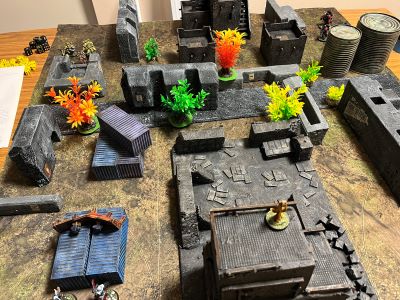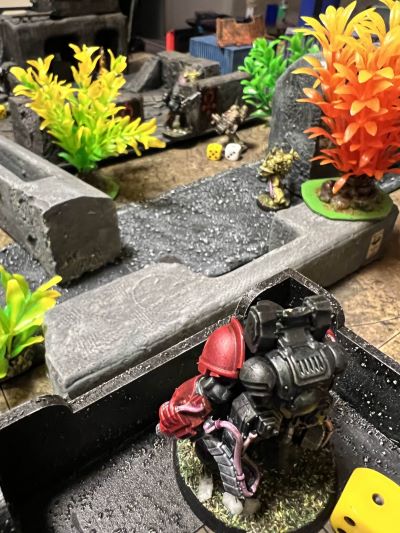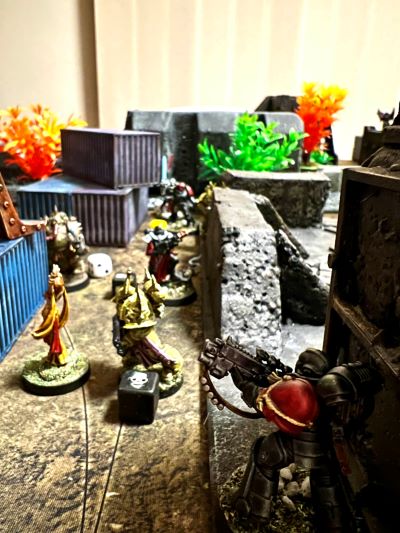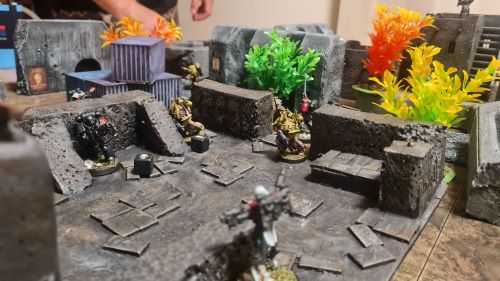In last weeks post I described a recent three player skirmish scenario I designed. You can check out the details here. A couple of friends and I played it through one evening the other week to see how it actually worked. In short, it was amazing fun. But I’m always interested in what I can learn from the experience to take into future games.
The Scenario
A miraculous manifestation has occurred on the planet of Helios Magna. A Saint touched by the power of the God Emperor, has manifested among the ranks of the Adepta Sororitas, but her fate is uncertain. The Inquisition, ever wary of uncontrolled power, has dispatched a team of Lancet Hereticus Space Marines to capture her for interrogation. Meanwhile, a force of Chaos Plague Marines, the Ferrymen, seeks to claim the Saint for a dark ritual, hoping to summon a daemon of the Warp into realspace.
The Sisters of Battle, unaware of what forces are closing in, have fortified their shrine compound to protect the Saint. What follows is a brutal three-way battle where each faction must act quickly to achieve victory.
The protagonists included:
Order of the Veiled Light: crack team of battle sisters tasked with protecting the Saint at all costs. Comprised battle sister and flying assault troops. (Played by Marty)
Lancet Hereticus: Inquisition sponsored space marine fire team sent to capture the Saint to check for heresy and research. Comprised regular marines and a heavy weapons specialist. (Played by Sean)
Ferrymen: Small plague marine raider unit intent on capturing the Saint for the nefarious aims of the ruinous powers. Comprised plague marines and a mutated brother twisted by the rot of Nurgle. (Played by me)

How it Played Out
The aim of the three player skirmish scenario was to get the action happening quickly and make sure all three players were engaged throughout. All three factions entered the fray on turn one with frantic positioning as well as shots being exchanged. Initial casualties were quite light.
There was some difficult decision making for all players around how aggressively to go after the scenario objective vs protecting your team. Excitingly, all three factions had control of the Saint at one point in the game only to lose her to an opponent. This meant that the outcome of the game was always in question.
A cinematic brawl involving all three leaders culminated in the Ferryman captain sneaking the Saint away at the last minute to claim victory at the start of turn 6. A win for the nefarious forces of chaos!

What Worked?
We used the One Page Rules skirmish ruleset: Grimdark Firefight, and it worked a treat. Fast, simple gameplay that had all three of us in the swing of things after the first move. With each player taking it in turns to activate a model this kept the game moving fast with no downtime for participants.
The victory conditions and time limit forced all three factions to engage with the objective pretty much immediately. It also kept each player battling on two fronts, no one was left out or ganged up on.
Finally, emergent play. All three players have some understanding of the 40K lore and got behind their faction and it’s aims. This definitely added to the immersion and I think colored some of the decision making as well. The cinematic three way duel by the captains at the end occurred completely emergently adding an awesome conclusion to the battle.

What Could Have Gone Better?
To be honest, not much. The battle flowed well and kept everyone engaged. The one thing I could have explained better at the start was the victory condition. There was a little confusion about how we achieved the win. We smoothed it out after turn 1, but clarity on this before we started would have helped.
Final Thoughts on Three Player Skirmish
All in all I succeeded in my goal of creating a fun, engaging, equal sided three-person skirmish scenario. The most important part was that we had fun playing. But I’ll be looking to see if I can come up with more three player scenarios in the future.
Of course, this battle now forms part of the Mordax Prime canon, my narrative setting for my 40K inspired gaming. With this victory for the ruinous powers, how will the Imperium authorities react? Will they mount a rescue mission? Or will the Saint become a tool of Chaos? We’ll find out in the next instalment…



